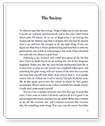Essay Instructions: This reflection should not read like an academic paper. Scholarly reflections ask you to consider patterns of thinking and/or your own experiences, identities, and social locations in relationship to what you have read/learned [see below for an example].
Here is an example of how you can successfully refer to the material without having to use direct quotations/in-text citations:
Before taking this class, I was not aware of the pervasiveness of ableism in American culture. Susan Wendall’s “The Social Construction of Disability” and Eli Clare’s “The Mountain” really shifted my thinking about [dis]ability. As an abled-bodied person, I hadn’t thought about how “super crip” messages construct [dis]ability as something to be overcome or transcended. The “super crip” mentality may seem like positive message at first; however, I learned that it centers ability as the norm and renders invisible the identities and struggles of people with [dis]abilities. “Super crip” messages imply that [dis]ability is an inherently negative condition and continues to oppress the [dis]abled community.
B. Good-Student
Women study
SAMPLE: Reflection Paper#
1 January 2013
We covered a variety of topics the past two weeks, ranging from disability, health, and gender identity. I noticed that the theme of exclusion kept coming up in the readings, even though it was not explicitly stated. Eli Clare’s The Mountain suggests that the dominant notion of “disability” is often constructed by non-community members. Clare suggests that this definition of “disability” includes only those with the most visible forms of disability (signified by wheelchair use, assistive technology etc), excluding those with less visible disabilities such as individuals with learning disabilities. Susan Wendall explains in her article, The Social Construction of Disability, that the category “disabled” is socially constructed in contrast to able-bodiedness. Through our social interactions, we learn about and reproduce a specific image of what it means to be “disabled” that may not reflect the broad range of abilities, identities, and circumstances.
Prior to reading, I did not think about how the term “disability” conjures certain kinds of imagery. I have certainly participated in this exclusionary behavior, both consciously and subconsciously. I never thought about how identities could be oppressive and how we reproduce these ideas in our every day interactions and language. When I was reading Clare’s piece, there were moments where I felt ashamed of the way that I may participate in ableism. I now can see that there is a broad range of experiences and needs that fall under a disability identity. I feel committed to being more mindful and not making assumptions about a person’s ability status/identity.
I was surprised to learn about myself while reading Clare’s The Mountain. I was diagnosed with Lupus in 2009* and I never considered the possibility of identifying as a disabled person. In particular, Clare’s concept of the “SuperCrip” both challenged me and affirmed some my experiences. First of all, I felt really hesitant about the use of the word “crip” because it is often used as a slur to refer to disabled people, but I can see why Clare may use it here. The “SuperCrip” is an ableist image of a disabled person or figure that transcends their disabilities and “inspires” able-bodied people (think “Special Olympics” imagery). For Clare, this image of the “SuperCrip” is oppressive because it ignores the very real limitations of a society structured around an able-body and how these norms actively exclude people with disabilities. I can see how Clare uses this term in a way to not only reclaim it, but to identify why this image is oppressive and damaging to disabled people. Not only had I never thought of chronic illness as a “disability,” but I, too, bought into the idea that “overcoming” illnesses or body limitations was a positive message. Clare explains that disabled people can internalize this message, too. I can relate to these ideas because I often feel invisible because people don’t understand how it feels to have a lupus flare. I can be hard on myself, trying to push through my fatigue and pain. Now I can recognize that I may have some shame about my illness and that this shame may be rooted in ableist ideology. At this moment, I’m not sure how I feel about the idea of identifying as a “disabled” person, but I can certainly see how “SuperCrip” messages enforce an exclusionary, ableist norm and that these expectations affect my life.
*NOTE: There is no expectation that you disclose information about yourself; however, you should feel free to incorporate what you feel comfortable sharing. The emphasis for this paper is on the learning process and what you learned. Sometimes incorporating our personal experiences can help us work through the course material, but there is no expectation that you do.
There are faxes for this order.


